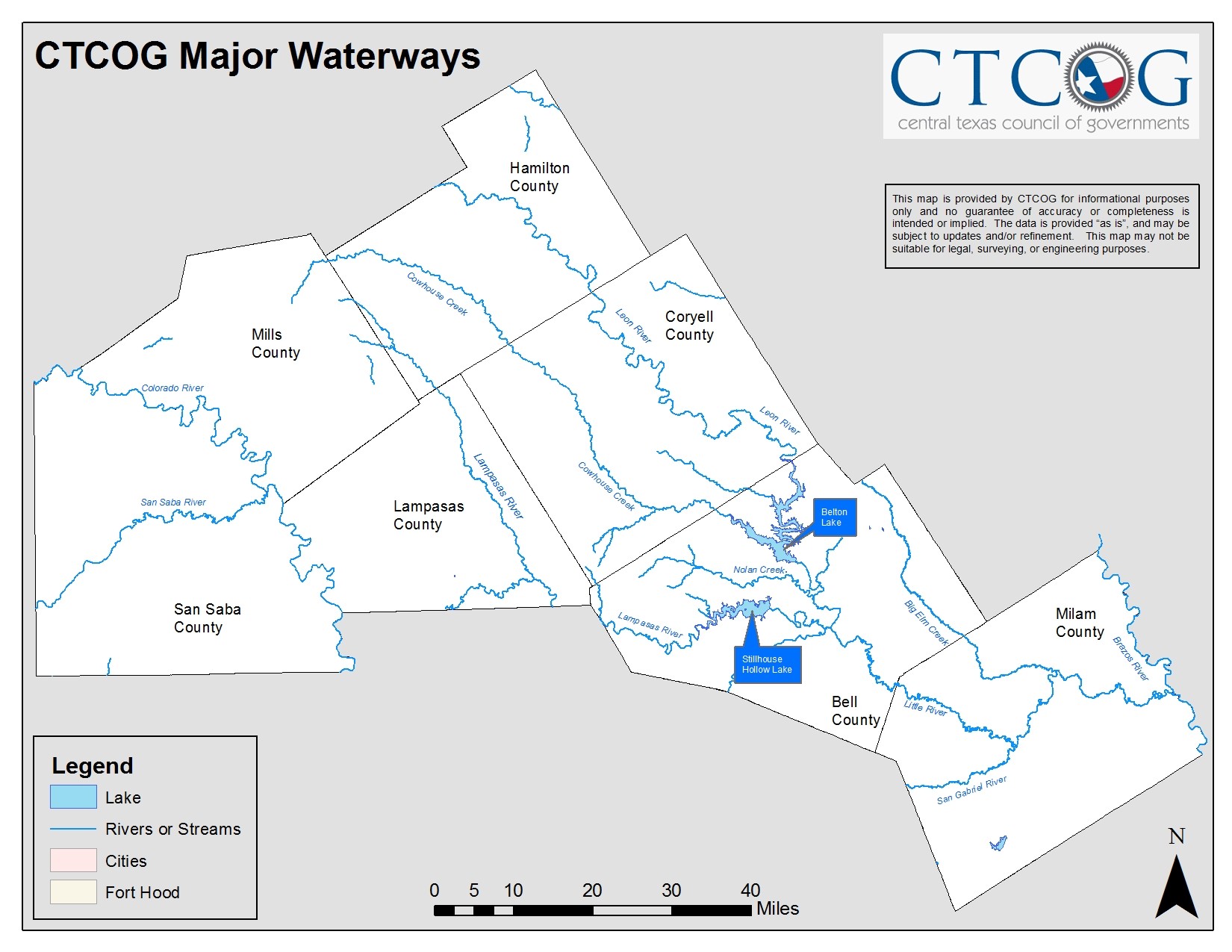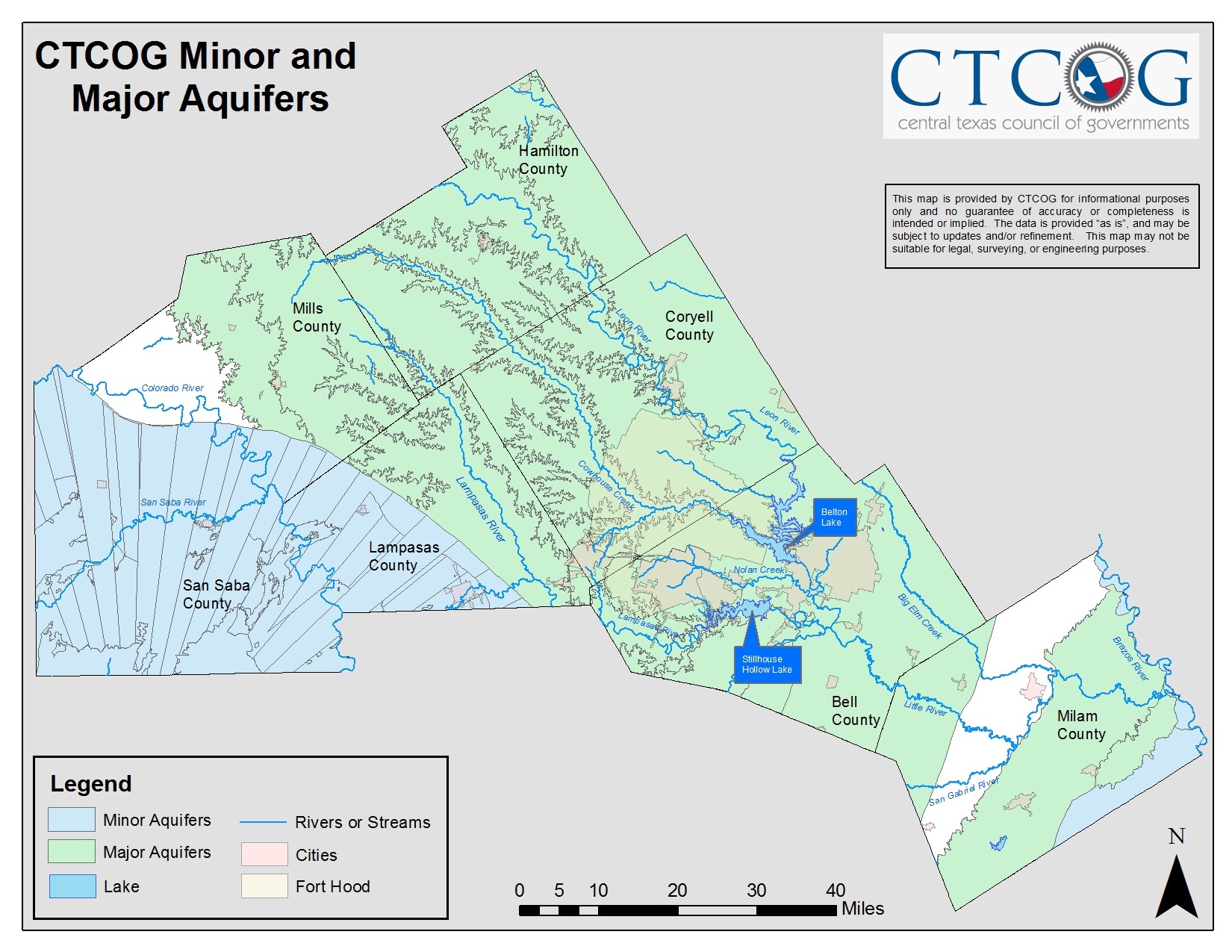Water Quality
The Central Texas Council of Governments was awarded funding through the Environmental Protection Agency (EPA) and the Texas Commission on Environmental Quality (TCEQ) to develop a CTCOG Water Quality Action and Outreach Plan. The grant started on September 1, 2023 and will conclude on August 31, 2025.

The water quality kits, and activity books are available for FREE to all teachers and homeschool groups or co-ops in the Bell, Coryell, Lampasas, Hamilton, Mills, Milam, and San Saba Counites.
Supplies must be picked up from the Central Texas Council of Governments 2180 N. Main Street, Belton, TX 76mailto:hope.davis@ctcog.org513 during regular business hours.
To place your order or for questions, email hope.davis@ctcog.org
Why is clean water important?
Water is essential for life. Polluted water in rivers, lakes and oceans becomes a liability for wildlife. Unsafe drinking water threatens, human health, crops and wildlife habitats. Pollutants come in various forms, such as fertilizer, paint, certain acids, cleaning products, livestock waste and toxic chemicals that are the by product of production of certain goods. Pollutants all have the one thing in common, they negatively affect the environment.
Historically, water quality standards have improved in the US. Since the passing of the Clean Water Act in 1972, there have been great strides to clean up our Nation’s waterways and prevent further contamination.
The Clean Water Act of 1972 established the basic structure for regulating discharges of pollutants into waterways and set regulations on water quality standards for surface waters.
The Clean Water Act provides the following protections:
- Gave the EPA the authority to implement pollution control programs such as setting wastewater standards for industries.
- Maintained existing requirements to set water quality standards for all contaminants in surface waters.
- Made it unlawful for any person to discharge any pollutant from a point source into navigable waters (unless a permit was obtained under its provisions).
- Funded the construction of sewage treatment plants under the construction grants program.
- Recognized the need for planning to address the critical problems posed by nonpoint source pollution.
The Clean Water Act has been effective in cleaning up our nation’s rivers, lakes and oceans. For example, Cleveland, Ohio’s Cuyahoga River would occasionally catch on fire due to high amounts of industrial waste in the river. Since the passing of the Clean Water Act, conditions in the Cuyahoga River have greatly improved.
Even though our waterways are cleaner now than before 1972, many rivers and lakes still suffer from contamination. According to the EPA’s National Rivers and Streams Assessment, approximately 46% of 1.2 million miles of rivers and streams were in poor biological condition; 25% of rivers surveyed were in fair condition; and 28% of rivers surveyed were in good conditions.
Improving water quality in Central Texas is in your hands. To learn more about water quality issues in the CTCOG region, please contact Hope Davis at 254-770-2376 or hope.davis@ctcog.org. We also offer presentations to local schools, communities and civic organizations.
Central Texas Water Resources
Section 303(d) of the Clean Water Act
Watersheds in our region are at risk of pollution. Many rivers throughout our region are susceptible to dangerous pollutants such as E. coli and excess nutrients. Rivers located in Section 303(d) list of the Clean Water Act are considered polluted, therefore, action must be taken to address water quality issues. Under Section 303(d), states are required to develop lists of impaired waters, prioritize them, and develop a Total Maximum Daily Loads (TMDL). TMDL is the maximum amount of a pollutant that can be present in a water body and still meet water quality standards.
Learn more about the Section 303(d) of the Clean Water Act.
Use TCEQ’s Surface Water Quality Viewer to look up the water quality status of rivers and lake in the State of Texas.
Regional Watershed/Flood Protection Plans
The Nolan Creek/South Nolan Creek Watershed Partnership, administered by the Texas Institute of Applied Environmental Research (TIAER) at Tarleton State University, in cooperation with the Texas Commission on Environmental Quality (TCEQ) focuses the development of watershed protection plan (WPP) that will address all water quality impairments and concerns in the Nolan Creek Watershed.
The Nolan Creek WPP identifies the cause and sources, water quality monitoring of current conditions, public education and to restore water quality for the Nolan Creek Watershed.
For more information on the Nolan Creek WPP, please visit www.nolancreekwpp.com.
In 2018 and 2019, the communities of Killeen, Harker Heights, Nolanville, and Belton with the assistance of the Brazos River Authority (BRA) and CTCOG applied for and received a Flood Protection Planning grant for the Nolan Creek watershed. The study developed new hydraulic modeling and analyzed different flood response strategies to aid in long term planning. The Nolan Creek Flood Protection Plan was adopted in September 2019.
Link to the final report: Nolan Creek Flood Protection Plan
Texas A&M AgriLife Reseach at Blackland Research and Extension center, Texas A&M University’s Spatial Scieneces Lab and Texas AgriLife Extension Service created the Lampasas River Watershed Protection Plan (WPP) in 2013. The WPP is a coordinated framework to address sources, causes and threats to both surface and groundwater, protect unimpaired water, restoring impaired waters and facilitate and encourage public education, awareness and involvement of water quality issues.
For more information, please visit www.lampasasriver.org.
The Leon Watershed Protection Plan was a multi-year effort by local stakeholders to reduce the levels of bacteria and nutrients in the river and its tributaries. The Plan was created in coordination by Parson Water & Infrastructure Inc. and the Brazos River Authority. The plan serves as a foundation from which to build on and achieve future water quality restoration goals.
The full plan can be found here: Leon River Watershed Protection Plan
Visit the website her: http://leonriver.tamu.edu/
Best Practices for Water Quality
Texas weather is extreme. Weather patterns can change drastically in a short amount of time. Texas, especially during the summer months, face the risk of droughts. When droughts occur, the need to conserve water is at an all time high.
Ways to conserve water are listed below:
- Turn off the tap while brushing your teeth.
- Fix leaking pipes and faucets.
- Use greywater to water your lawn.
- Install a water efficent showerhead, dual flush toilets and front loading washing machine.
- Use native plants or xeriscape for landscaping in drought prone areas.
Nonpoint sources of pollution results from land runoff, precipitation, atmospheric deposition, drainage, seepage or hydrologic modification. NPS pollution is caused when pollutants are carried by rainfall or snowmelt moving over and through the ground.
Nonpoint sources of pollution can include:
- Fertlizers, herbicides and insecticides from agriculture.
- Oil, gas, and grease in runoff.
- Sediment from construction sites, crop and forest lands and erosion.
- Bacteria and nutrients from livestock, pet wastes and faulty septic systems.
What can you do to prevent NPS pollution from polluting streams?
- Keep litter, pet waste, leaves and debris out of street gutters and storm drains.
- Apply lawn and garden chemical spairnly and according to directions.
- Dispose of used oil, antifreeze, paints, and other household chemicals properly.
- Clean up any spills from cars.
- Purchase household detergents and cleaners that are low in phosphorus to reduce the amount of nutrietns discharged into lakes.
To learn more about NPS pollution, please visit the www.epa.gov.
Products, such as, paints, cleaners, oil, batteries and pesticides contain hazardous materials that need special care when disposing these items. When these items are not properly disposed, these dangerous materials can contaminate streams, rivers, lakes and groundwater. Contaminated bodies of water can effect the wildlife and humans that use water from these areas.
To properly dispose hazardous chemicals, find a household hazardous waste event in your area. Through the CTCOG Solid Waste Grant, hosts HHW events each year to collect hazardous household waste. These events are open for residents located in the seven county region of the CTCOG (Milam, Bell, Coryell, Lampasas, Hamilton, Mills, San Saba).
For more information, please visit the EPA Household Hazardous Waste page.
The proper use of pesticides and herbicides is critical to maintain the quality of our water. When pesticides and herbicides are applied, they have the potential to run off to sites that could impact our water. Pesticides and herbicides in water can be toxic to fish and wildlife and human life.
What are some ways you can prevent pesticides and herbicides from polluting our water?
- Apply pesticides and herbicides directly to the plant and not directly to bodies of water.
- Use extra caution when applying in areas where they can be washed into waterways.
- Avoid applying during windy and rainy conditions.
- Sweep up all debris that may have pesticides or herbicides into a trash can.
- Store pesticides and herbicides in a covered area and dispose leaking containers.
According to the Texas Commission on Environmental Quality, pet waste is a top contributor of bacterial pollution in urban watersheds. Pet waste may conatin harmful bacteria such as E-coli, parasites, and salmonella. Stormwater can carry pet waste and directly deposit them into waterways where the waste will start to decompose. During decomposition, the waste uses oxygen needed by fish and other creatures to stay alive and healthy. Please pick up after your pet to help keep our water safe.
Litter consists of waste products that have been disposed improperly. examples include aluminum cans, plastic bags, cardboard boxes, and tires that are found on the ground. Hazardous materials that are dumped improperly can enter waterways and contaminate these areas. Organic litter, such as livestock waste can cause water pollution and lead to the formation of algae blooms through the process of eutrophication. When livestock waste enters a body water, nutrients located in the waste develop algae blooms due to the high nutrient concentration. The algae blooms use the oxygen located in the water causing oxygen to be depleted. This can lead to organisms who rely on oxygen in water to die.
Financial Aid
The Texas Water Development Board has information regarding State Revolving Funds and other financial aid opportunities. See the pamphlets below for more information.
Important Links
- Environmental Protection Agency
- Texas Commission on Environmental Quality
- TCEQ Nonpoint Source Program
- Texas Clean Rivers Program
- Brazos River Authority
- Take Care of Texas
- Clearwater Underground Water Conservation District
- US Army Corps of Engineers-Ft. Worth District
- National Integrated Drought Infromation System
- United States Drought Monitor
Contact Information
For any questions or information regarding CTCOG water quality education and outreach program, please contact James McGill either by phone at (254) 770-2366 or by email at james.mcgill@ctcog.org.
PREPARED IN COOPERATION WITH THE TEXAS COMMISSION ENVIRONMENTAL QUALITY AND U.S. ENVIRONMENTAL PROTECTION AGENCY.


